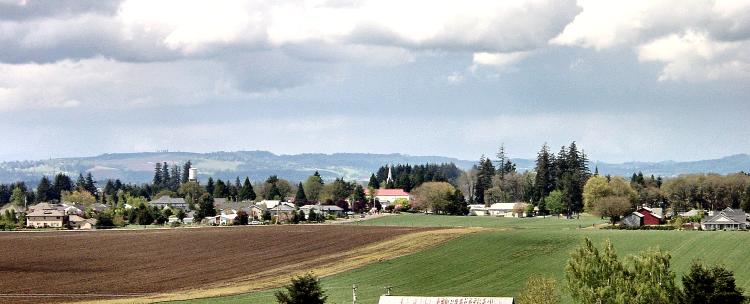

125th Anniversary of Saint Boniface in Sublimity 1879 - 2004
Sublimity Historical Outline
This is a single long web page in chronological
order. We suggest you first scroll down through the years to sample
the color and character and get your bearings. You can always go
back with ![]() , but don't miss the
wonderful old photos farther down!
, but don't miss the
wonderful old photos farther down!
You can also jump to "chapters" of this page by clicking on one of
these: (Use ![]() to return here.)
to return here.)
Beginnings College Catholics Benedictines Fr. Ruettimann Sisters
Schools Church Fr. Lainck Church_cont. Frs. Scherbring 1955 on
This is a popular history drawn from locally gathered photos, notes, church records, state archives, local newspapers, and town historians - with special thanks to Vera Boedigheimer, shown here, and Evangeline Ripp. Sublimity, The Story of an Oregon Countryside 1951 by the late Mark Schmid OSB, PhD, Librarian at Mt. Angel College, gave us an indispensable overview.


This scene would be typical for early settlers leaving for Sublimity from Missouri in the 1840s. They came by ox train from Indiana in the 50s and by rail from Minnesota in the 70s. The earliest settlers arriving in the Sublimity area via wagon train over the Oregon Trail include several families, for example the Glovers, the Riches, and the Hunts, described through their diaries. Too lengthy to include here, you can read them at St. Boniface Community Archives & Museum
Sublimity Historical Outline - In The Beginning
Sublimity, Oregon is a rural residential community about 15
miles east of Salem. It is situated on the western low foothills of
the Oregon Cascades, on a plateau, amid gently rolling hills
dropping down all around into grassy valleys.
The earliest inhabitants of the area came a few thousand years ago,
perhaps descendants of Asiatic tribes that entered America by way
of Alaska. Indians living in Oregon wandered far up and down the
country in search of game or fish. Those who lived in and about the
Santiam countryside were mostly of the Calapooia Tribe. Those who
lived nearest to Sublimity on the south were known as Santiams,
whereas the Mollalas often approached from the north, since the
north-south Indian trail led through the Sublimity country.
The area was a mostly a vast forest before the 1840's, but the
Sublimity area was bare because the Indians regularly burned it to
provide feeding grounds for deer which they hunted for food.
Government surveyors were among the first white men to look over
the area. Josef Brohn was noted as a white man that surveyors
encountered in the Sublimity area. He lived in a log cabin with a
vegetable garden about 1/2 mile west of town on what was known as
the Wm. Smith place in 1875.
1840- Sublimity had its beginnings as an Indian village and then a
trading post.
1848- It was originally named "Hobson Corner" after Hadley Hobson,
a brick contractor from North Carolina, who came to the area after
inadvertently ending up in California instead of Oregon. Mr. Hobson
made the best of the situation by gold mining until the fall of
1848 when he boarded a sailing vessel in San Francisco and arrived
in the Columbia river after five weeks of seasickness. He took up a
claim on Mill Creek north of Stayton, building his home on what has
since become known as the Miller place, where he settled with sheep
and cattle and raised a family of ten.
1850- James M. Denny received a Donation Land Claim grant of one
quarter section as follows:
Certified Copy of Patent. The United States of America Book, 83
Page 539 By the President, Dated Nov. 18, 1858 James Buchanan,
L.S., Recorded Dec. 22, 1903 to James M. Denny Certificate numbered
two hundred and eleven Notification No. 57 has been established to
a donation of one quarter Section, or One Hundred and sixty acres
of land, and that the same has been surveyed and designated as
Claim Number Sixty nine and as part of Section Thirty four and
Thirty five in Township Eighty South of Range one West according to
the Official Plat of Survey returned to the General Land Office by
the Surveyor General, being bounded and described as follows, to
wit: Beginning at a point ten chains East of the North west corner
of the South east quarter of Section thirty five in Township Eight
South of Range one West, thence South twenty six chains and eighty
links; thence west sixty chains; thence North Twenty six
chains;_sixty six and two thirds links and thence East sixty chains
to the place of beginning, in the Willamette Land District Oregon
Territory, containing one hundred and sixty acres and forty two
hundredths of an acre. Do give and grant unto the said James M.
Denny, the tract of land above described. To have and to hold the
said tract, with the appurtenances, unto the said James M. Denny,
and to his heirs and assigns forever. By Act of Congress approved
September 27, 1850

1852- Sublimity received its official name when a US Territorial
post office, one of the first six in Oregon, six years before it
became a state, was established. The name Sublimity was selected by
James Denny because of the "fine vista and sublime scenery" in the
hills around the town. Sublimity has the distinction of being the
only place in the United States (or perhaps anywhere) with this
name. Denny became the first postmaster and the post office was
located in his store until the 1870s. It was then located in the
Hobson store where Mr. Denny distributed mail from the office
window. Mail from the East came by way of Hawaii, taking about six
months. Subsequent post offices were in homes, stores, and a shoe
repair shop.
The date of this photo of a coach in front of the Stayton post
office is uncertain.




Sublimity Historical Outline - The College
1853- A group of 98 members of the United Brethren in Christ church, which opposed slavery and secret societies, made up a colony that came by ox train from Indiana, arriving in the Willamette valley near Albany in September. They established churches and schools there and later John F. Brewer, in search of more land for the members, came to the Sublimity area.
1854- The Sublimity School District was formed. The school constructed that year was a log cabin near the present west end of Division St. It cost $500.00 and served nearly until the end of the century, when it was replaced by a more modern building in town.
1854- Drury S. Stayton became postmaster.
1855- James M. Denny died. He was unmarried with no children. His parents, John and Sarah Denny, inherited his land.
1856- Charles H. Crawford became postmaster.
1856- Solomon Alberson became postmaster.
1857- After three years of growth the United Brethren settlement decided to establish a school in keeping with their ideals of education. Sublimity had become a natural center for settlers, and the United Brethren decided to locate their school here. On January 14, 1857 a bill was introduced in the legislative assembly at Salem:

James Denny had donated the land and the two-story, 18x35 foot
frame building (with lumber from a saw mill near Jefferson), was
constructed in record time on nearly the exact spot where the St.
Boniface high school later stood. A panoramic view overlooks the
valley to the south and east.
1858- In January the bill was granted and the college formally
opened. Trustees named in the charter were "John Denny (father of
James), Thomas J. Connor, Eli Hubbard, D. S. Stayton, Jesse
Harritt, William Bishop, Jeremiah Kenoyer, David B.MacMillan, James
M. Campbell, Allen J. Davie, Hadley Hobson, Solomon Alberson, G. W.
Hunt, James M. Chandler, Morgan Rudolph, and their associates and
successors." They held the college and its properties in trust for
the United Brethren in Christ church, a branch of the Mennonite
church in Indiana. It was empowered to "grant and confer degrees in
the liberal arts and sciences to such pupils of the institution . .
." Algebra, geometry, English, ancient languages, music etc. were
taught. This gave Sublimity the early distinction of being a
"college town." The academic level ranged from the primary grades
up, but did not much exceed high school level.
It became especially known for two things - its outstanding Latin
department, and its baseball team, which had beaten Willamette
University on its home field. The first teacher and headmaster at
the college was Milton Wright, later to be made a bishop of the
United Brethren church. Wright, who was a strict disciplinarian,
stayed two years at Sublimity college, then was recalled to Indiana
by his church, where he soon married and fathered Orville and
Wilbur Wright, world famous for their invention of the
airplane.
Tuition was $5 for the first twelve weeks. Advancing students were
charged an additional fifty cents a subject. Latin and ancient
languages cost $9.00 per term, higher English $7.00.
 Bishop Milton
Wright
Bishop Milton
Wright
1859- Oregon was admitted to statehood on February 14.
1859- Masonic Lodge #25 AF&AM was consecrated as Sublimity Lodge June14, 1859. Partial records list 18 petitions for the degrees of Masonry from 9 farmers, 4 carpenters, a miner, schoolteacher, merchant and mechanic. The first elected officers were: Willis Duningham, W. Fulbright, Peter Biliyew, Thomas Evans, F.B. Sprague, B. Hutton, Tyler. There were ten voting members. The Charter was surrendered Sept. 22, 1863. So many of the people returned to their home states to fight in the civil war that Sublimity was almost deserted. - Bob Brundage
1860- "The 1860 Federal Census listed the three largest cities in Oregon as Portland with 2,874 persons; Sublimity, 1,221, and Eugene, 1,183. The smallest community reported was Illinois Valley with a population of 5 lonesome souls. Salem was in between someplace. The Rand-McNally people report that the 1860 census showed a total of 52,465 persons in Oregon. This did not include some 7,000 Indians "who retain their tribal characteristics"." (From an article in the Oregon Statesman, Feb. 3,1959. Yes, this is surprising, and I wonder if the Sublimity figure included some of the adjacent areas.)
1860s- Sublimity had been bustling when the Civil War broke out. It had a Chinese laundry, five stores, a gun maker's shop, public school, college, Methodist Church, United Brethren Church, hotel, post office, public well and a furniture shop. Some say Sublimity was as large then as it is now. The Civil War caused a severe decline in Sublimity's population as settlers returned to their native states to fight, dissension over slavery being intense. The town became deserted; the college closed but reopened in 1865 at the end of the war. It closed permanently in 1870.
1861- David Simpson became postmaster.
1862- Philemon Morris became postmaster.
1863- Sublimity elementary school officially became District No. 7, with 110 students. The term was extended from three months to five months, and teachers were paid $20.00 monthly.
1866- John W. Cusick became postmaster
1866- J. R. Sellwood, a graduate of Willamette University, assumed
presidency of the college. He later became a prominent Portland
businessman - the Sellwood district bears his name. The fourth and
last president of Sublimity college was Prof. John W. Garrison.
Through his efforts the enrollment reached l25 by the end of the
1860s. "We taught a little of everything." Local students lived at
home; others boarded at the school or with local residents. However
the withdrawal of the United Brethren church and the depression
following the Civil war hastened its closure. Too, both the public
school district, which itself had decreased to 50 students, and the
college taught some of the same subjects and both depended on the
available public money. Another reason suggested for its decline
was competition from Philomath College, another United Brethren
institution southwest of Corvallis, Oregon. It's building survives
as a museum.
1867- Hadley Hobson became postmaster.
1870- Robert L. Swartz became postmaster
1870- Sublimity College closed suddenly and permanently.
Sublimity Historical Outline - The Catholics Move In
1870's- The first Catholic settlers, German immigrant farmers,
came to Sublimity. They were an industrious and persistent lot, and
their arrival eventually transformed the depressed hamlet into a
busy rural village supplying trade to the area.
1872- Philemon Morris became postmaster.
1874- Nearly all the abandoned farms in the area were re-possessed
by these new people and the town grew rapidly. Many of the new
settlers came by rail from German colonies which had previously
located in Minnesota or Wisconsin.
1874- M. Haupt became postmaster.
1875- Ernest Becker became postmaster. He had lost his left leg in
the battle of Shiloh ("Hornet's Nest") in the Civil War in
1862.
1876- Nicholas LaCroix, a Sublimity storekeeper, became
postmaster.


1877-1879 The first Catholic services were held in private homes, and later in a leased building (see below). There were only about five Catholic families in Sublimity at the time but they asked Archbishop Blanchet for a missionary priest, and in 1879 Father Peter Juvenal Stampfl arrived. He was a German via Minnesota and encouraged Midwesterners to immigrate. (Note: According to the 1880 US Census P. Juvenal Stampfl was a Catholic priest born in 1853 in Austria.) He wrote the first entry in the parish record on December 3, 1879, which marks the official beginning of Saint Boniface Church in Sublimity, Oregon:

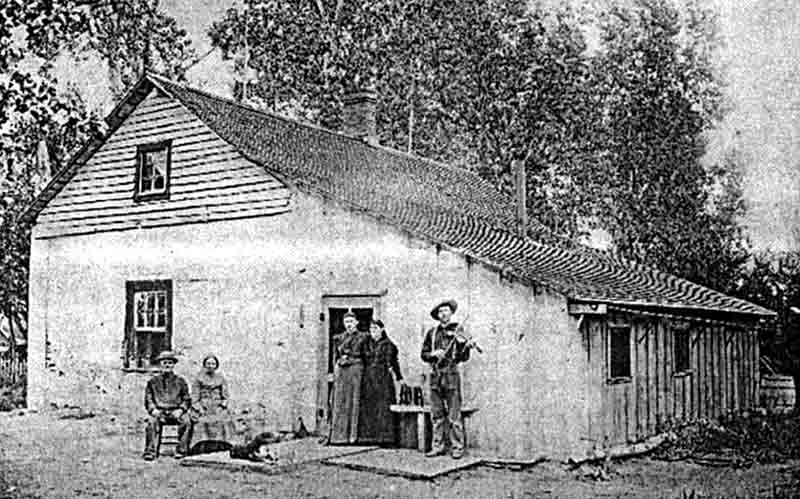

A hotel and rooming house, the Parker House, stood on the Anton
Van Handel place, marked by the circled "1" in Center St. in the
map above. Across the street (now the Sublimity Building Supply),
marked by the circled "2", there was a vacant building which was
leased as the first St. Boniface church
in 1877 and used for a couple of years. It collapsed in a heavy
snow in 1880.
1880- Father Stampfl purchased the empty and run-down college
buildings (just northeast of the present church) and 20 acres for
the parish in January. One acre was designated the Cemetery of the
Angels. The ground floor became the second St. Boniface
church. Father Stampfl returned to Minnesota in 1881
(a few months before the Benedictines arrived in Gervais and took
over the care of Sublimity) but returned later to visit.
Sublimity Historical Outline - The Swiss Benedictine Contribution
(Note: A lot of early short-term pastors are listed below.
Most of these were Benedictine monks on non-resident assignment.
Note too that assistant pastors or priests in residence as high
school teachers are not, as a rule, listed below.)
1881- Father Adelhelm Odermatt OSB was the first of the Benedictine
pastors, and visited on horseback once or twice a month.
". . . a native of Switzerland and a member of the 800-year-old
Benedictine Abbey of Engelberg, Switzerland (he) came to the US in
1873 and arrived in Oregon in 1881. After an extensive search all
over western Oregon, he picked the Mt. Angel butte for a new abbey.
The town at the foot of the butte went through a variety of names -
Fillmore (after the U.S. President), Frankfort, and Roy among them.
But when Father Adelhelm decided to build the monastery there he
asked the postmaster to change it to Mount Angel, the anglicized
name of his Benedictine headquarters in Switzerland.
1881-1882 Abbot Adelhelm Odermatt OSB, pastor 
photo courtesy Ernie Shea
1882- Father Nicholas Frei OSB, pastor 
1883- Father Barnabas Held OSB, pastor 
1883-1884 Father Anselm Wachter OSB, pastor 
1884- Father Bede Horat OSB, also from Switzerland, visited
Sublimity once a month. He would arrive Saturday evening, celebrate
Mass on Sunday, preach once or twice, teach the children catechism,
and return to Gervais on Sunday. (from an 1883 letter of Abbot
Odermatt published in
Sublimity Historical Outline - Good Father Werner
1884- Sublimity received its first resident pastor, the Swiss
Father Werner Ruettimann OSB, aged 27, also arriving via Gervais.
He had studied in Switzerland both at The abbey of Einsiedeln
(which had founded St. Meinrad Abbey in Indiana) and at the abbey
of Engelberg (which founded Mt. Angel Abbey in Oregon).
1884-1889 Father Werner Ruettimann OSB, pastor 
The old college building had been purchased in 1880. Being divided
into small rooms it did not make an ideal church, but the first
floor was being used as the second St. Boniface church. The upper
story, with its broken windows, was still the domain of bats and
pigeons. Father Ruettimann took up lodging on the first floor near
the front door.

Father Ruettimann was also responsible for the communities of
Jordan and Scio. Several young women were living a semi-religious
life in the Jordan colony, southeast of Sublimity, when Archbishop
William Gross visited and invited them to become a formal religious
community. (For the full and fascinating story read These
Valiant Women by Wilfrid P. Schoenberg SJ. The settlement of
Sublimity by mid western Germans is connected with that of Jordan,
but is hardly as bizarre.)
Note: Centennial History 1885-1985 Our Lady of Lourdes, Jordan,
Oregon, editors Barbara Bentz, Linda Duman, and Fr. Gregory
Moys, covers the Jordan settlement and its background.
1885- Because of a disagreement with their trustees the Jordan
sisters left to live for a few months with the Benedictine sisters
in Mt. Angel as they planned to move to Sublimity and begin their
new life as the Sisters of the Precious Blood, later to be known as
the Sisters of St. Mary of Oregon. Father Ruettimann arranged for
the upper floor of the college building to be used for the sisters'
convent, and also built a two-story addition onto the back of
it.

1885- Meanwhile, Ditters' store, shown here in 1910, was started by John Ditter from Wisconsin in partnership with George Bell. The crossroads site was a popular one for the purpose, having been the scene of the early Hobson Corner store, and near that established by Nicolas LaCroix, a French-Canadian trader from Gervais in the 70s. Ditter's began as a drugstore and tobacco shop, later selling general merchandise - buggy oil, kerosene lamps, barrels of pickles. . . The pump on the right was for thirsty horses.
Sublimity Historical Outline - The Sisters of St. Mary
1886- When the old college building was nearly ready it became the first convent of the newly founded religious order. The building was decorated with evergreen boughs for the occasion by the nine sisters, and the two Boedigheimer brothers, who had moved to Sublimity from Jordan. (Taking photographs was a rather stiff process in those days.) Father Ruettimann called the new convent "Mariazell" after a favorite shrine to Our Lady in Austria. But it was very primitive, and the sisters had little in the way of furnishings or even food starting out.


Above, the interior of the chapel of the convent, formerly a
study hall in the college.
Later, after the erection of a new convent for the sisters, the old
college building was used as a parish hall. Many German Catholics
arrived from the middle west and more adequate space was
needed.
Sublimity Historical Outline - Schools, Public and Parish
1887- Sublimity Public School District No. 7, (Image courtesy of
the Oregon State Library, Salem, OR, Siegmund Collection)
Left to right, back row: Engel Schott, Perry Smith, August Klinger,
Ed Gilbert, Tom Davey, Alvah Smith, Henry Smith, Bill Cooper, Bert
Veal, Will Ledgerwood.
Second row, left to right: Ethel Stanton, Olga Hobson, Jessie
Hobson, Rhoda Hobson, Belle Stanton, Mamie Ledgerwood, Mr. E.A.
Bennett (teacher), Ella Glover, Fannie Lee, Emma Udell, Nellie Lee,
Hattie Clark, Celine Klinger, Lena Lee, Emma Miller, Otillia
Becker.
Front row, left to right: Roy Miller, Alfred Klinger, Jim Udell,
Art Gilbert, George Glover, Frank Hobson, George Pritchet, Dan
Stanton, Price, unidentified, Joe Becker, Nona Lee, Amanda
Becker.

1888- A substantial new rectory was built to replace the tiny two room house Fr. Ruettimann had been living in. It was replaced in 1957.

1888- The Sisters of St. Mary opened the first parochial school in Marion County, in a new one room schoolhouse built by Joseph Spenner. Below we see the first school with the first resident pastor, the Rev. Werner Ruettimann. Half the day classes were taught in German, half in English, as many of the settlers spoke German. In the distance we see the rectory to the left, and in the middle the former Sublimity College building with the "addition" on its right side. (It was later salvaged from the 1910 fire that destroyed the original college building. It was moved north, used as a convent, and later moved again onto the M. Hassler place, and became the start of the future Marian Home.)


1888- The same St. Boniface grade school, with the first teacher, Sister M. DeSales, a Franciscan from Wisconsin, who came for a year to also instruct the new nuns.
So then there were two school systems, public and Catholic, working together. For many years following, Catholic nuns also taught in the public schools, after passing the state certification exams. (At that time not many attended school beyond the fifth grade.)
1889- Friends from back east had sent the Sisters a bell that rang for the first time on New Year's day. Sadly its first peals announced the death of young Father Ruettimann at age 32 of tuberculosis. He was buried in the hilltop cemetery at Mount Angel Abbey. (On a recent Sunday afternoon I visited his grave. I also saw the headstones there of Abbot Odermatt 1844-1220, Fr. Bucholzer, Fr. Wachter, and even of Fr. Schmid, the historian of Sublimity, d. 1971.)

1889- Father Anselm Wachter was Vicar, and for a few months there was no pastor until Prior Odermatt at Mt. Angel could first send Father Eugene Bolla OSB and then Father Joseph Bucholzer OSB, natives of Switzerland.

Sublimity Historical Outline - Sublimity Builds a Proper Church
1889- Father Joseph Fessler arrived from Milwaukee, Wisconsin, took over the parish duties, and built the third (the present) St. Boniface church. It is still in continuous use and very much in its original condition. The heavy hand-hewn timbers came from the farm of William Schmidt. I.J. Boedigheimer provided the sawn lumber. The contractor was from Gervais. In 1889, Fr. Fessler wrote in German cursive in the parish record book (I translate):
 etc.
etc.
"John Weiss was here on August 15th and we negotiated the building of the church concluding that he would complete the exterior for the sum of $500. At this time the timber had already been cut by the church members.
Here is a charming letter to the editor of the Catholic
Sentinel from an anonymous Sublimity farmer, published Sept.
16, 1889.
"We are building a handsome frame church, 36 x 72 feet, if I am not
mistaken. I expected that someone else, who knows all about it,
would post our esteemed Catholic newspaper, but as everyone is
silent about it, I, although only a common farmer, undertake to let
you know what is going on in Sublimity.
"Our most beloved Archbishop has sent us an excellent parish priest
in the person of Rev. Joseph Fessler, who is by the way, also a
rustler in the best sense of the word. He makes things go ahead in
spiritual and temporal matters.
"The first Sunday of September was quite a feast for our
congregation. The Benedictine Prior of Mt. Angel blessed the
beautiful cornerstone, and preached on the text: "No one can lay
another foundation but that which is laid, which is Christ Jesus."
The Rev. speaker congratulated the new pastor upon his great
success in building the new church. He praised the solid, well done
rock foundation, and admonished the faithful of the congregation of
Sublimity, as true sons of St. Boniface, the Apostle of the
Germans, to be one heart and one soul with their good shepherd in
erecting the house of God, this most beautiful monument of true
Catholic faith. He thanked all those who contributed towards the
new church in cash or in hauling building material, and encouraged
all to rival each other in the noble work. Our dear, beloved pastor
then sang High Mass with deacons from Mt. Angel.
"The lovely feast concluded in the afternoon with solemn vespers
and Benediction.
"Mr. John Weiss, of Gervais, has the contract for the new church,
now in course of erection, and whoever knows John Weiss as church
builder, already knows beforehand, what a handsome church we folks
of Sublimity are going to have. We are happy. A fine priest, a fine
church, fine farming land, and all we need yet is a few more good
Catholic farmers."

The church was dedicated by Archbishop H. Gross of Oregon City
in honor of St. Boniface on October 26, 1889. On this same day the
bell that had been meant for the convent was blessed for the new
church. Ten persons were confirmed, and four women were welcomed
into the Sisters of the Precious Blood.
Interestingly, Father Fessler, of independent means, also had
established his own dairy, sheep farm, and extensive orchards. He
also promoted the Sublimity area in eastern newspapers.
1889-1891 Father Joseph Fessler, pastor 
Archbishop Gross of Oregon City. (In 1928 the archdiocese changed
to Portland.) 
About this time, the addition Fr. Ruettimann had made to the college building was removed to the present location of the convent building for use by the sisters:

1890- Center Street, Sublimity, looking south. The rooming house or hotel is at the right; the stores are farther along. (Sublimity, Story of an Oregon Countryside by Mark Schmid left to right: first two unidentified; Mr. Weidner, X.; W. Copps; Kinsey; B. Neal; C. Heater; C. Darst; B. Cooper.)

1891- The Sisters were asked to move their convent to Beaverton to provide teachers for an orphanage. There too they had better buildings and 600 acres of land. Father Fessler left with them to help manage. They soon had a barn built, and two Sublimity men volunteered to drive their cows to Beaverton. In 1894, the Sisters began the construction of a new Motherhouse in Beaverton, and in 1905 changed their name to the Sisters of St. Mary, known today as the Sisters of St. Mary of Oregon. (The St. Boniface convent continued to house the local teaching sisters.)

Thanks to Joe Spenner, this fine logging scene is at
Gale Creek near Verboort, Oregon with Wm. VanHandel on the
right, before settling in Sublimity, after perhaps traveling with
these oxen to Oregon.
1891-1892 Father Joseph Kempker, pastor 
1892- Augusta H. LaCroix (Mrs. Nicholas LaCroix) became
postmistress.
1892-1893 Father Peter Beutgen OSB, pastor 
1894-1895 Father Joseph Bucholzer OSB returned as pastor. 
1894- John A. Ditter became postmaster.
Sublimity Historical Outline - The Golden Era of Father Lainck
1895- Father Anthony Lainck arrived as pastor via Gervais. He
was born in 1865 of noble parentage in Graes, Westphalia, Germany.
His early home training and gifted personality fitted him well for
his future task. He studied theology at the University of
Innsbruck, Austria, and was ordained there in 1891. His kindness
and sociability soon won for him many friends among Catholics and
non-Catholics alike in Sublimity and Stayton.
(Anthony Hall, home of the local Knights of Columbus, is named for
him.)
1895-1927 Father Anthony Lainck, pastor 
1896- After a series of small farm fires, a group of farmers organized the "Farmers Relief Association" to provide mutual insurance, later known as Sublimity Insurance Company.
1898- Meanwhile, back to the Hobsons! The photo below is from Dorothy Graham, whose grandfather Lemuel Hobson, father of Henry H. Hobson b. 1894, owned this old family home on the east side of the Stayton-Sublimity road, now the Miller (century farm) and Hottinger property.

1898- The building on the left, the second St. Boniface grade school, was built to supplement the first one in the right rear, that built by Joseph Spenner ten years earlier.

| Oregon Statesman, New Year's
Edition, 1 Jan 1899 Sublimity is one of the most prettily situated towns in the valley, standing upon an elevated ridge at the south end of the long range of "Waldo Hills" and overlooking in every direction one of the most beautiful and fertile stretches of country the eye could wish to behold. The town and the country surrounding it for a few miles is settled largely by Roman Catholics, there being nearly 100 families of that persuasion tributary thereto. There is a large Catholic Church, St. Boniface, which is in charge of Rev. Anthony Lainck, who has a numerous congregation. There is also a Catholic parochial school, taught by the Sisters of the Precious Blood, with from 60 to 75 pupils constantly. The past season an additional new building became necessary for this school. Sublimity has also a fine public school building, with a large attendance and good teachers. Of course there is also quite a population in the neighborhood who are not Catholics. It is a very prosperous community in every way. There are two good general stores, a blacksmith shop, shoe shop, dressmaking, a saloon, etc. Grain, fruit and hop culture, dairying and stock raising form the leading features of the agricultural pursuits of this section and the surroundings of the inhabitants indicate much thrift, enterprise, freedom from debt and general comfort. Property in and around Sublimity is a desirable and sure investment. The town has two daily mails, telephone service, and is but four miles from a railroad station. It is fifteen minutes southeast of Salem |
1902- Sublimity was incorporated and granted its own charter
through the efforts of Senator Wm. M. Hobson.
1903- The first city officials were elected: John Kintz, mayor;
J.A. Ditter, treasurer; Theodore Odenthal, recorder; Philip Meier,
marshal; and J. Hassler, H. Hunke, B. Prange, and A. Riesterer
councilmen. Salaries ranged from $25.00 for marshal to $5.00 for
the treasurer. The city had no income and very little business to
transact. Its first ordinance, adopted in June of 1903 read, "It
shall be unlawful to allow sheep, goats, hogs, or horses to run
loose about the streets of the corporate limits of the city of
Sublimity. Failure to heed this ordinance shall endanger the
transgressor for a fine of five dollars, or imprisonment in jail
from two to ten days...." The city fathers were faced with their
first real problem when the marshal apprehended the first
transgressor - the fellow would not pay the fine, but they had no
jail. The sentence was suspended until a "cooler" could be built.
(ref: Sublimity, Story of an Oregon Countryside, Mark Schmid,
1951)
1903- Edwin Mckinney became postmaster.
What with the dark, muddy streets, many lacking sidewalks, the
disorderly saloons, and the unavailability of electric power, the
council bought six kerosene street lamps. These were lighted by
hand evenings and extinguished in the morning. Perhaps one of these
can be seen in this 1907 photo near the right wooden sidewalk on
Main St.

1903- In Stayton the Catholic community built themselves a church. It is said that the steeple was made a foot higher than Sublimity's! Immaculate Conception was dedicated in 1904 (photo below courtesy Vera Boedigheimer), but it was not until 1931 that they had a resident pastor. Father Lainck drove his horse and buggy to Stayton to say mass there on alternate Sundays.

1903/4- Hottinger-Ditter clans:
Grandpa Hottinger

1903- St. Boniface church received minor additions in the sanctuary and sacristy.
1903- The National Catholic Order of Foresters fraternal
organization was organized, and sponsored this celebration in
1904.


1904- Look at the detail in this 4th of July scene. The old college building in the background had served as a church and convent before the new (present) church on the right was built. On the float reigns Rosey (Becker) Riesterer, 16, Goddess of Liberty.
1904- A new rural postal route began from Sublimity to Silver
Creek Falls.
1905- In the Stayton Mail: Rural mail carrier B.S. Branch went to
the fair and brought back a wife.
1906- The first crushed stone paved roads and by 1913 nine miles
of road were completed, for a cost of $18,000.
1906- Mary J. Prange became postmistress.
1907- Here is a class of public school district No. 7, Sublimity
with its teacher, Sister Imelda.

Top row from left Charles Schmitt, Henry Boedigheimer, George Boedigheimer,
Joe Ripp, Philip Alders, Felix Steinkamp. Joe Pieser
Second row George Prange, Sister M. Imelda, Rose Kintz, Christine Ripp, Emma Peters,
Tillie Leverman, Dean Miller, Bertha Hendricks and Tony Steinkamp
Third row Theresa Hottinger, Joe Steinkamp, Ida Doerfler, Dora Smith. Theresa
Rauscher, Marie Odenthal, Mary Benedict, Lena Fischer, Pauline Heuberger, Hattie Hendricks
Bottom row Mary Lulay, Lena Hermens, Gertrude Lulay, Grace Hottinger, Dora Albus,
Arvilla Wagner
1907- The Women's Catholic Order of Foresters was organized, and the hall was erected. (1915 photo, it was razed in 1980.) The hall was owned by the C. F. Association, which issued shares in it. It was a popular venue for weddings, dances, etc.

Sublimity Historical Outline - Finishing Touches
 St. Boniface
Church, 1910
St. Boniface
Church, 1910
1908- The present historic St. Boniface church, built in 1889,
is the second oldest original church in the archdiocese of
Portland. It was in 1908, under Father Lainck, that the present
fine bells and altars were added. The altars were built by
Engelbert Gier, all handmade and decorated with gold leaf.
The three large bells in the bell tower in front of the church were
cast by the "Henry Stuckstede Bell Fdy Co, St.Louis Mo 1909." They
bear this notice and the following legends in Latin:
Larger bell: BONIFACIUS VOCAT POPULUM SUUM (Boniface calls
his people)
Medium bell: SANCTA MARIA, ORA PRO NOBIS (Saint Mary, Pray
for us)
Smaller bell: SANCTA BARBARA, PROTEGE NOS IN HORA MORTIS
(Saint Barbara, protect us in the hour of death)
The smallest bell (only 350 pounds) is in the 110 foot steeple, and
it is the one that had been donated to the new convent in 1888. It
is inscribed G. Campbell and Sons, Centennial Bell Foundry
Milwaukee Wisconsin 1888 (top), Mariazell Convent of the Precious
Blood, Jesus Mary Joseph (bottom).
A Happy Note: While many churches have now silenced their bells out
of deference to the "heathen," Saint Boniface' bells are loud and
clear, and herald the Angelus daily now as in the Middle Ages.

(Above is the interior in 1908, below before 1908.)

1910- The old college building burned to the ground in an accidental fire.
1910- The Sublimity Telephone Company was incorporated.

1910- Here are a couple of photos from the "horse and buggy" days.

Above, left to right: Lena Hermens, Mary VanHandel,
Jesse (the horse).
Bill Van Handel had purchased property northeast of Sublimity near Triumph road. His oldest daughter, Mary, stayed with relatives in Verboort while the new home place was prepared for the family. Early one summer morning, all by herself, Mary left for Sublimity in the buggy shown with Jesse, who was a fast walker. After about 75 miles they arrived at the crossroads of the Sublimity/Silverton Silver Creek roads. Jesse balked and refused to continue straight east. It was near sunset and Mary was very concerned, then remembered her dad saying if Jesse ever gave any trouble, to "let him have his head." She loosened the reins and he turned south to Sublimity and they soon arrived safely, after dark at the new homesite. (Photo and story thanks to Joe Spenner.)

Above: Joseph Zimmerman
1911- Mr. and Mrs. Arnold VanHandel celebrated their 50th wedding anniversary, here with 8 of their 12 children.


Joseph and Elizabeth Bany Susbauer family at the Catholic Foresters
Hall in Sublimity, celebrating their golden wedding anniversary,
1925.
Gunnell and Robb Studios,
Salem, Oregon, Thanks to Gene Ditter
1912- The Sublimity Dairy Association was incorporated.

Hermens Creamery: Pete, Bill, and Adrian Hermens, Nick Gehlen with team.
1912- October, after several large fires, the City of Sublimity formed the Sublimity Fire Department. The fire department acquired one A.G. Long #10 chemical fire engine that had a 45 gallon tank, two wagon style wheels, two kerosene lanterns, an axe and a crowbar. Information as to the leadership of the department is sketchy, however G.H. Bell was president at its formation. Many names still common to current Sublimity appear on the early rosters, such as Zuber, Ditter, Etzel, Ripp, Susbauer, Kintz, Riesterer, and Welter.
1912- The first public well was dug.
1913-1914 Through Father Lainck's efforts a new two-story school was completed north of the church and west of the convent. The Sisters of St. Mary taught the 9th and 10th grades (under Sister Imelda in 1916), as well as the 7th and 8th in the old public school building, north of the creamery. Father Lainck was energetic and effective in helping both nuns and youth.

1914-1915 Sublimity installed electric street lights from the Stayton Light Company, paid for by a special city tax.
1915- Another July 4th.On the float, standing from left: Edith Highberger, Lena Hermens (Goddess of Liberty), Grace Hottinger. Driver: Pete Hermens, Creamery horses, from left: Duke and Don. Center: Baribeau house. (Joe Spenner's photo)

1915- The town square, 103 Main St. looking north. From left on the Ditter, Bell & Co. porch: the Doctor, George Bell, Mrs. Nick Zimmerman and two boys, John A. Ditter.

1915- Roy E. King of Sublimity (courtesy Santiam Historical Society). He rests in the Union Hill / King cemetery near Sublimity.

1916- The St. Joseph's Verein was organized in Sublimity. It was a Catholic organization founded at Klagenfurt, Germany in 1893 for the advancement/preservation of religion, social and cultural ideals, and good literature. The local group is seen here in front of St. Boniface church, with Fr. Lainck in the front row, second from the right. The Verein merged into the Holy Name Society 1n 1929.

1918, Feb. 8 - Stayton, Oregon Grade School, grades 7 and 8. I
did not want to leave Stayton out, and this photo courtesy of the
Santiam Historical Society in Stayton provided a welcome
opportunity, since my late great friend Giles Brown is front row,
second from left. We shared our interest in old violins. Giles
played Sundays at the Mt. Pleasant Community Church.
The names are listed (probably not in order) as George Mielke,
Giles Brown, Lawrence Smith, Clarence English, Lyle Lampman, Nickie
Fehlen, Dick Child, Cleo Weddle, Louise Reiger, Mary Tate, Willis
Scofield, Gilbert Hammer, Norwood Eskew, Nettie Geymer, Tillie
Spaniol, Alma Nendel, Sara Caldwell, Tresa Forrette, Emma Miller,
Elnice Farrar, Irene Lee, Rosie Allis, Margaret Henal, Elizabeth
Lee, Alta Meyers, Lauren Chapman, Kenneth Thomas, Cecil Schick and
Miss Nora Crabtree.

1919- This photo shows the sisters from Sublimity at
Beaverton.
Back row: Sisters Magdalene Giebler, Theophane Ruettgers, Johanna
Silbernagel, Cecilia Boedigheimer, William Tuettgers, Father
Anthony Lainck (visiting pastor from Sublimity), Cyrilla Ruettgers,
Vincent Ritzinger, Theresa,C.j. Ruettgers, Germaine Heuberger
Third row: Sisters Thecla Schmid, Mechtild Hendricks, Gertrude
Silbernagel, Theresa Heuberger, Aloysius Bender, Barbara Hassler,
Boniface Prange
Second row: Sisters Eulalia Benedict, Rosalia Benedict, Anthony
Heuberger, Innocentia Spenner
Front row: Novices Antonina Lulay, Felicitas Minten, Immaculata
Frank.

1919- I. J. Boedigheimer and Helen Frances Smith's 25th wedding anniversary in 1919, taken on their front porch in Sublimity.

1919- Young Mary VanHandel holds a pan full of freshly cleaned trout.

1920 - Joe Schrewe resting after falling a Douglas fir on his
land in southwest Sublimity. The stump looks to be about seven feet
wide.
Born in Germany, Joe died in 1961 at 88. He had three children.

1920s - Tony Van Handel's Harness Shop. Jim Ripp worked here. It
is now the site of Dr. Heuberger's veterinary office. A leather
horse collar rests on the plank sidewalk.

1920 or so- Barney Ditter, Leo Susbauer, and Ernie Riesterer. Video games had not yet arrived.


The Paris Woolen Mill was in Stayton, but Sublimity provided a
some managers and many workers, including these ladies:
Standing right front, Hilda (Starr) Schumacher; Anne VanHandel to
Hilda's right; and probably Ida and Angeline Hartman's mother; and
__Albus in the center back.
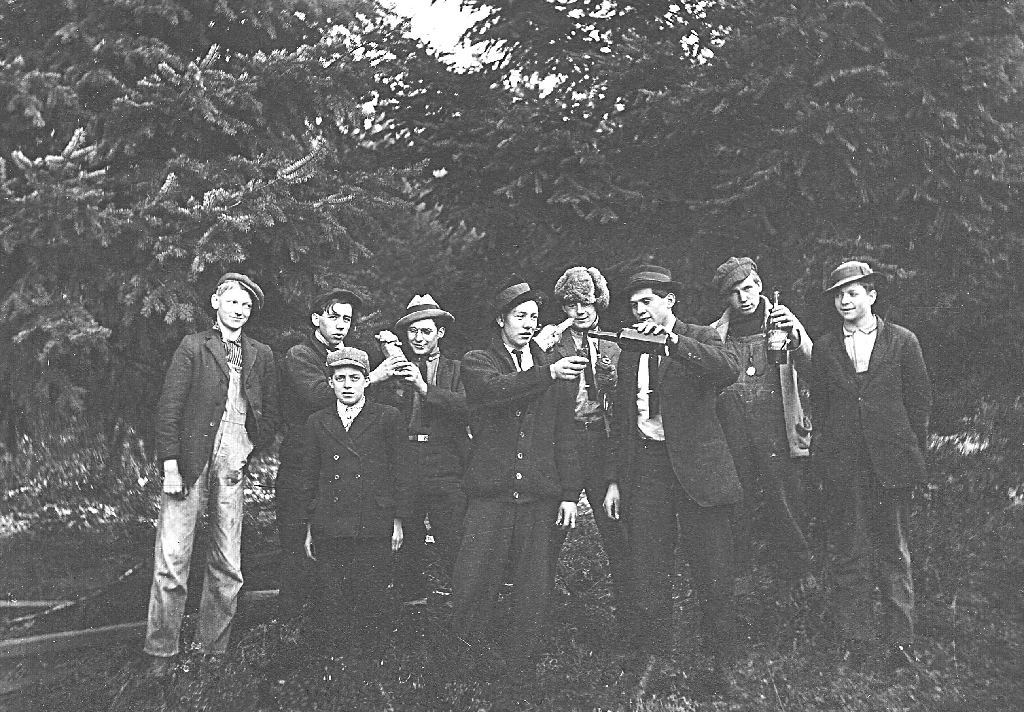
Lyons, Oregon High School, date and occasion unknown - we can only
guess!
1920- Father Lainck's 25th Anniversary as pastor. He had built the school and rectory, remodeled the church, and built the church at Stayton as a mission.
1923- Oregon passed the "garb bill," which prohibited public school teachers from wearing religious dress. This cooperative arrangement was followed: Grades 1, 2, and 3 were taught by the sisters in the Catholic school; grades 4, 5, and 6 were taught by district teachers in the public school, and grades 7 and 8 were taught by the sisters in the Catholic school. The district also rented a classroom in the Catholic school.
1923 Frank Bell became postmaster.
1923- The Knights of Columbus organized St. Anthony's council #2439 in Sublimity.
Like other Sublimity families, Mathies and Bernadine Schmid shared sons and daughters with the church. In the front row, left to right, are Sisters Rosaria and Thecla, and Fathers Mark and Leo. Mark wrote the history Sublimity, Story of an Oregon Countryside in 1951.
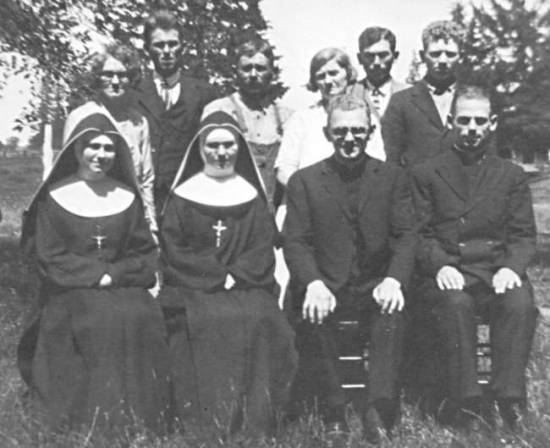
1924- Mrs. Antoinette Hermens became postmistress for 18 years.

1926- Philip Steffes of Sublimity discovered a native thornless blackberry otherwise identical to the thorny evergreen blackberry, and as productive. It quickly became the most popular blackberry in the country, and was grown extensively in Oregon. It was later hybridized into the aromatic and intensely flavorful Marion berry.

1927- Father Lainck died after a first vacation trip to his German birthplace, having served St. Boniface parish for 32 years. The Stayton Mail of June 16th, 1927, echoing the sentiment of all who knew Father Lainck, wrote,

This bronze sculpture was placed by Father Siroski in Father Lainck's memory. Eventually the Scherbring brothers were added.
Sublimity Historical Outline - The Scherbring Years
1927- Rev. Francis Scherbring was appointed to minister to the
Sublimity and Stayton parishes. He had served previously at Salem
and Shaw. He organized the Young People's Club. Noting the growth
in the sublimity area he made plans to build a new Gothic church;
these were near the final stage when he unexpectedly died in
1935.
1927-1935 Father Francis Scherbring, pastor 

Women's Catholic Order of Foresters Drill Team.
Standing, left to right: Cecilia (VanHandel) Maertz, Pearl
(Doerfler) Zuber, Grace (Hottinger) Ditter,Nettie (VanHandel)
Gries, Clara Zuber, Julia (Boedigheimer) Gries, Angeline (Kintz)
Hassler, Effie Gescher, Aurelia (Kintz) Podrabsky, Edna Ditter,
Angie (Zimmerman) Jungwirth, Ilsabette Ditter.
About 1928- Below, back row, left to right: Mary Hendricks, Gus Hendricks, Genevieve Hendricks, Anna Ditter. Front row, left to right: Joe Ditter, Herman Hendricks (on lap), Mary Ditter, Anna Hendricks, Leonard Hendricks, John A. Ditter, Catherine Ditter.

1920's and 30's- In these years many sawmills were established
in the area. Their operators had names very familiar in Sublimity
today: Breitenstein Bros.; VanHandel Brothers; John Frank & A.
Minden; A. & B. Minden; Stuckart & Minden; Frank Etzel; Ted
Freres; Amandus Frank; J.B. VanHandel; Sim Etzel; Peter Gries;
Lulay Brothers.
Below, left to right:Below, left to right: Joe Susbauer, Dan Kintz, Frank Etzel, Isidore Bell, Ed Etzel, Paul Zuber, Bill Hermens, Charlie Schmitt, Engel Schott, Bill Odenthal, George Doerfler, Tony Schindler, Joe Benedict, Nick Lulay.

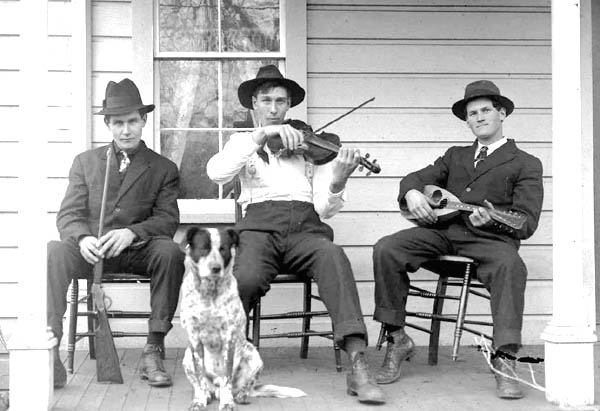
Above, left to right:Joe Schulte, Carl Schultebein, Gus Hendricks
The Sublimity Fire fighters sponsored an annual talent show to
build individual interest in the arts, music, theater as well as
baseball and basketball. The basketball team was known as the
"Hawks" and frequently won trophies among the seven Santiam Valley
teams. East of town on the Zimmerman place a baseball field with
bleachers was built by Wm. Lulay in 1932. Mr Lulay organized and
managed a team in season.
1932- The WWI memorial was dedicated in the city park, a cannon and
brass plaque with the names of 54 local servicemen and women.
1933- The Sublimity public grade school class

1933- The nearby Silver Creek Falls Park was dedicated with 1030 acres and nine waterfalls ranging from 25 to 198 feet tall.

1934- The Confectionary in Sublimity, Ben Toepfer proprietor. Ben started with food and "near beer" during Prohibition, later had the real thing. (Courtesy Santiam Historical Society) This building and bar served as Meier's Sublimity Saloon early in the century.

1935- Following the death of Father Francis Scherbring, his
brother, Father Joseph Scherbring, who had served as pastor of the
Stayton parish 1931-1935, was appointed his successor. A building
program was soon outlined, beginning with the hall and
gymnasium.
1935-1955 Father Joseph Scherbring, pastor 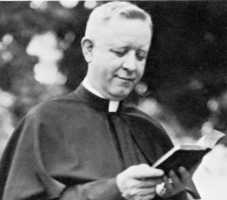
1936- Here we have a "what might have been." According to historian Mark Schmid Fr. Francis Scherbring had wanted to build a larger church. We still have the architectural drawings and specifications "Complete Church Plans by E. J. Gier, Proposed 1937, Estimated by Barrett And Logan." According to a March 5 headline in the Stayton Mail, "Plan $55,00 Catholic Church at Sublimity; Work Will Start Soon on Project," Construction was to start immediately and the church with full basement and faced with light Willamina brick was to be debt-free when completed. The concrete foundation had in fact been laid before the project was abandoned, for whatever reason, during Fr. Joseph Scherbring's time. What actually went wrong with the building fund is clouded in rumor and speculation, which we will not pursue here. Below are photos of two of the blueprints and an architectural rendering:



You may note a similarity in style with St. Mary's church in nearby Mt. Angel. Its architect too was Engelbert Gier, who with his builder brother Emil had come from Germany via Texas.
1937- Eugene Ditter was appointed Fire Chief after Chief Tom
Reuf dies of Pneumonia. "Gene" served until the mid 1970's.
1937- Sublimity Fire Department acquired a 1931 International
pumper. This pumper was the first motorized fire equipment in East
Marion county and is still on display.

Top from left: Tony Schrewe, Wilfred (Barney) Ditter, Ernie Riesterer, Dan Meier, Bill Riesterer, ?Ray (Red) Boedigheimer
Bottom: Eugene Ditter, Ben Toepfer, Herman Hassler, Jerome (Bud) Ditter, ?, Leo Susbauer, Bill Duchateau, Pete Boedigheimer.
1940s- Sublimity got a new municipal water system, a new grade school, two general stores, a building supply store, and a tavern. Wheat, oats, and barley were major crops.
1940- The "activity hall" (in 1888 the first parish grade
school) was converted into the first St. Boniface High School. Four
years of high school were taught in its three rooms by the Sisters
of St. Mary. The first graduating class included Camilla Lulay,
Bernice Ruettgers, Dolores Bentz, Loretta Etzel, and Joe
Spenner.
1941- The St. Boniface Hall and Gymnasium building was built for
$7500.
1942- Clara Neal became postmistress.
1942- Wartime photos:
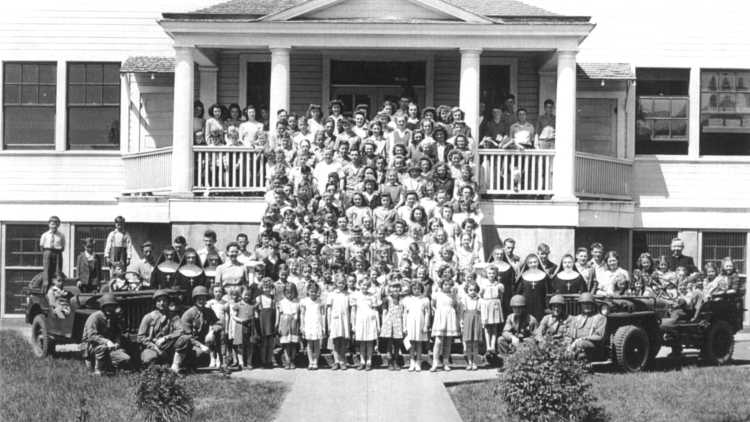
Above: The students of St. Boniface school in Sublimity were
over their wartime bond drive quota. The soldiers and jeeps here are from Camp Adair,
Corvallis, Oregon, 1942.
Below: St. Boniface High School graduating class of
1942

Top row - Joe Gerspacher, Donald Toepfer, John
Laux, Fr. Joseph Scherbring, Ed Spenner, Clifford Laux, Vincent
Spenner.
2nd row from top - Richard Schumacher, Eobert
Schumacher, Gene Heuberger, Kenneth Bentz, Richard Spaniol, Matt
Gerspacher, Joe Dombrowsky, Paul Dombrowsky,
3rd row from top - Doris Albus, Velma Lulay, Doris
Susbauer, Maxine Kintz, Betty Bender, Lillian Weeder, Muriel Gries,
Marcella Gries, Avone Nightingale, Lorraine Duchateau.
Bottom row - Delores Wolf, Catherine Duman, Ruth
Lulay, Dorothy Lulay, Vera Hassler, Mark Schulender, Dorothy
Lambrecht, Rose Mary Dombrowsky, Doris Vanteicher.
Courtesy of Vera Hassler Boedigheimer
1945- A new brick St. Boniface High School was constructed west of the gym with a capacity of 7 teachers and 100 students. Sisters of St. Mary and priests in residence at St. Boniface taught. The athletic program thrived.


1946-47 - Sublimity Hawks town team. Won 19, lost 1. Front l-r: Kenneth Bentz, Orville Lulay, Tony Gerspacher, Bernard Bentz, Arlyn Birkholz, Back l-r: Billy Lulay, Leonard Frank, Eugene Heuberger, Matt Gerspacher. Missing: Leonard Neal, Eugene Russell, Richard Schumacher, Lawrence Ripp, Stan Russell, Harold Etzel.
1947- Sublimity built its water system including a 370 ft. well and a 50,00 gallon water tower with asbestos pipes - how times have changed!
1948- A modern convent (below) was built across the street from the new High School, replacing the old college "addition", which was moved south to the Hassler place.

1949- A new district 7C grade school was built on the current site, finally for all eight grades.
1949- The Rural Fire District was formed. One engine was purchased, equipped, housed and manned in the Sublimity Station.
ca 1950- Lively Saturday nights were provided by local
musicians, many from Sublimity, at the Aumsville Pavilion. This is the "Rangeriders" band.
(Aumsville Historical Society photo)

Front row from left: Mary Jo Hendricks, Larry and Rose Hendricks, Ron Bentz. Back row right: Another Sublimite, Al Etzel. Mary Jo directed the St. Boniface choir for many years, and performs in her own popular band.
1955- With the parish proper being cared for, Father Scherbring
began the unfolding of a long cherished dream - a home for the sick
and aged in the peaceful setting of Sublimity. In failing health,
he lived long enough to officiate at the blessing of the Marian
Home on August 7. But on August 25 he suddenly passed to his
eternal reward, sorely missed by all for his piety and
kindness.
The Marian Home had its roots in Minnie Hassler, a kindly single
lady who had been looking after elderly folks in the old convent
building that had been moved onto her eight Church Street acres,
which she later donated for Father Scherbring's Marian Home. It was
originally run by a staff of six Servite nuns from Austria, two of
whom are seen here in the kitchen. From the beginning it was
non-sectarian. Marian Auxiliary, Inc. was incorporated in 1957 as a
non-profit (see third photo below) and was dissolved in 1975. It is
privately operated now as Marian Estates, with about 400
residents.



Sublimity Historical Outline - Further Growth and Change
1955-1969 Father Robert Neugebauer, pastor 
1957- The Santiam Golf Club was founded on March 4 by A.J. Frank, Roy Phillipi, William Gehlen, John D. Davis, Walter D. Miller, Harmon Drushella and M. L. Morey, all golfers. Ralph Lulay is the current president (2011).

(from across the freeway, pouring
rain) © 2011 Denny Barnes, Stayton, Oregon
1957- A new brick rectory was built, including a parish hall.
1959- There was more room in the cemetery then. (Salem Library photo)

1960- After 108 years Sublimity finally got a real post office building. Postmistress Clara Neal received many requests from afar for first day cancellations from the only post office in the world named Sublimity. (A letter arrived from London, England simply addressed to "Sublimity.") It replaced the post office in Mrs. Neal's home, below.

1962- The Columbus Day storm, Oct 12, "blew out" the new Post Office. (Salem Library photo)


1962- With the opening of the shared Regis Catholic High School in nearby Stayton, St. Boniface High became vacant, and St. Boniface grade school moved in. The 1913 grade school was razed in 1963.
1962- Ed Hassler next to a field of orchard grass. (Oregon State Archives) Doerfler Farms of Sublimity is the largest grass seed producer in the world. Christmas trees are also a major crop in the Sublimity area, and are shipped worldwide.

Folklore - According to the late Gene Ditter, there was a time when wheat and oats were the main crops and the grass was considered a nuisance. "It was commonly known as the "Damn Ditter Grass." For a number of years they (farmers) tried to kill it because it got mixed up in their grain. But it spread all over the valley here." How did it get here?
1964- 
Telescope builders - These Regis High School (established 1962 in
Stayton, Oregon) students are building an 80 power reflecting
telescope in their spare time. They are (clockwise from front)
Dennis Gilleran, William Lulay, Joe Sprauer, Robert Neal, and David
Sherman. Joe Spenner, Maintenance Engineer, is the adult supervisor
on the prokect. (Photo thanks to Joe Spenner.)
1972- The Sublimity Harvest Festival began. The largest show of its kind west of the Mississippi, it draws over 30,000 visitors on the weekend following Labor Day. The emphasis has shifted through the years from grass seed farming to tractor, draft horse, and truck pulls to "monster trucks," etc. Originally in town it now has permanent competition fairgrounds adjacent to the local Chemeketa Community College.


1969-1975 Father Thomas Gadbois, pastor 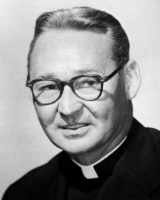
1973- Carol Moll became postmaster for about 28 years.

1975-1986 Father Daniel Hurley, pastor 

1979- St. Boniface Church celebrated its centennial with an outdoor Mass con celebrated by an Archbishop, three Bishops, an Abbot, its pastor Fr. Hurley and numerous other priests! Left to right are Bishop Steiner (who was to celebrate the 125th anniversary mass - see the 2004 photo below) Bishop Leipzig, Archbishop Power, Bishop Waldschmidt, and Abbot Anselm OSB.
1986-91 Father Edward Altstock, pastor 
1987- the Rural Fire District annexed the City Fire Department
to become the current Sublimity Fire District.
1989- A new Headquarters Station was built on Parker St.
Great-grandfather was First Sublimity Settler by Carl Hobson,
Keizer, Oregon (a letter to the editor, date?)
"I have been following with interest the possibility of the town of
Sublimity merging with Stayton. I am opposed based upon a personal
interest.
1991- Fire chief Kevin Hendricks moved to Woodburn, replaced by Jerry Heater. The district acquired more pumpers, medic/rescue units and other equipment and a second station on Drift Creek Road.
1991-1994 Father Glenn Dare, pastor 
1993-1996 Father William O'Malley SJ, pastoral vicar 
1993- The school district purchased the St. Boniface school property for $650,000.
1993- Sublimity gets its first motel!
1993- A Catholic Sentinel photo. The caption states "St. Boniface Church is the only one in the archdiocese to have its reredos (altar wall) still intact."

1994-1997 Father Galdino Monteiro SFX, pastor 
1995- Alan W. McMahen became Sublimity's first career fire chief.
1995- Delbert and Yvonne Ditter retire and sell the 105 year old family grocery.
1996- On July 1, Sublimity School District No. 7 became part of the North Santiam School District.
1997- The Santiam Canyon Stampede was established as an annual PRCA Rodeo at the Sublimity Harvest Festival grounds in early August.


1997-2001 Father Arthur Dernbach, pastor 
1999-2000 The church was structurally reinforced, prompted by concerns from the 1993 "spring break" quake.

2000- The old Ditter grocery building was razed, replaced by the brick Ditter Town Square.
2001-2002 Father Michael Sprauer, pastor 

Colorful new mural on the old 1960 post office building reflecting its new use as a telephone office. Sublimity now has a large new post office, below, 2002.

2002-2005 Father Patrick Donoghue, pastor 
(2002- In December I registered the domain name www.saintboniface.net for the parish. In November 2003, with Fr. Donoghue's blessing, I put it "on line" with the Sunday bulletin and have added other features since then, as this history.)

2003- Sublimity's superfluous water tower failed to sell on Ebay!
2004- Sublimity's mayor (for the second time) is Ray Heuberger DVM. Heubergers have been part of the church and town from the early days.


2004- June 5 was the 125th anniversary of our parish and the 1250th anniversary of the martyrdom of Bishop Boniface. Mass with Bishop Steiner. German sausage picnic and music in a huge tent welcome to the community. Display of historical artifacts, such as this door from the old Sublimity College, supplied and displayed by Sublimity's favorite historian, Vera Boedigheimer.
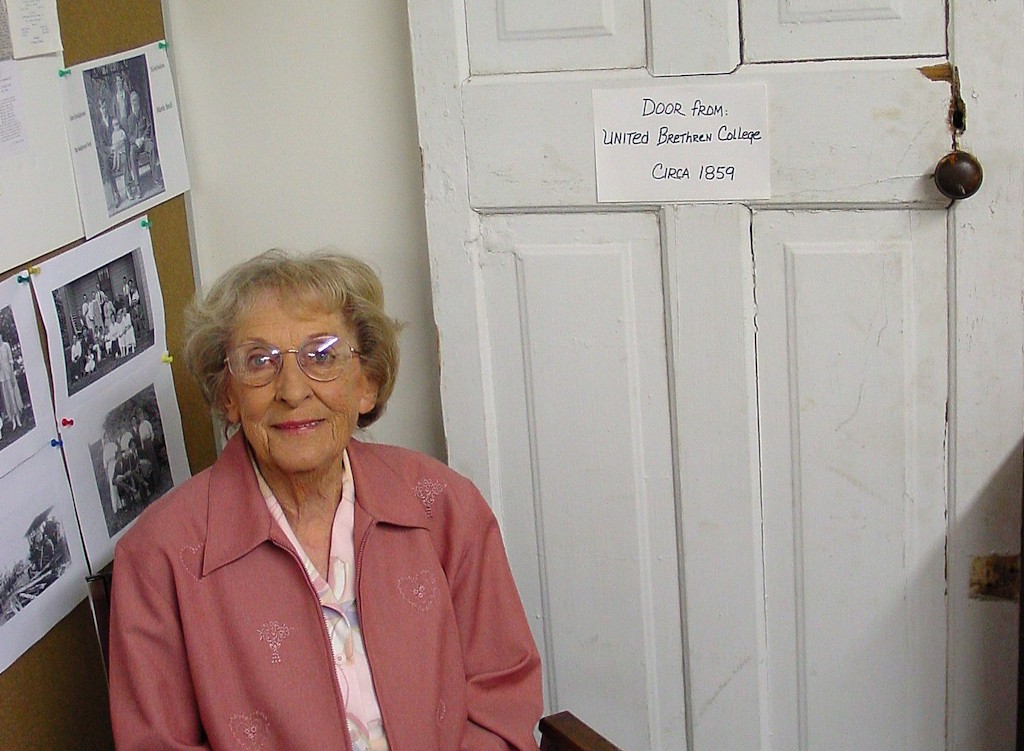

Photos in the choir loft and afterwards in front of church.


(On Dec. 5, 2004 Archbishop Vlazny came to celebrate the beginning of our church register on Dec. 3, 1879 by the first pastor, Fr. Peter Stampfl. (see 1879 above)
2005 (July-September) Fr. Irudayaraj Amalanathan, administrator


Tim Bielenberg barbeques famously for a Choir picnic at Strobels', July 2005

Annual Parish Picnic, August 2005.
Our new priest, Fr. M. Jeyamani Paul, gives his first
Sunday homily, October 2, 2005

2005 - Your webmaster was appointed to the twelve member Archdiocesan Historical Commission.
2005 - Our website caught the attention of the BBC, who sent a television crew to interview parish members, including local historian Vera Boedigheimer.
2006 - In February the Archives Committee was reestablished with a new location in the Convent building and a renewed commitment to collect, preserve, organize and share heritage resources.

The archives group were given a tour of the Santiam Historical Museum, which includes Sublimity historical items, by Carol Zolkoske, center. A few of those present were, from the left, Henry Strobel Jr, Ralph Lulay, Carol, Vangie Ripp, Francis Hendricks, Evelyn Fuson (museum staff), and Vera Boedigheimer.
2006 - Six months later, in August, there was an "Open House" for the new archives facility. For lots more about this program, see Sublimity History.

You'll also read there about the past and present St. Boniface Annual BBQ Chicken Dinner, serving over two thousand this year. Carol Rambousek provided PR, including even an interview of both archives and dinner representatives on Albany radio station KGAL.
2007 -
2007 In November the St. Boniface Archives Office and Museum
moved from its modest earlier facility to prime space in the
southwest quadrant of the old convent building opposite the church.
There's lots more about the Archives at St.
Boniface Community Archives & Museum
2007 The state of Oregon is giving Jim and Shirley Heater a Sesquicentennial award. The Heater family has been working the same Sublimity area farm since 1852 (156 years). It's grown to about 5000 acres, of which 3500 produce Christmas trees for worldwide export. Lorenzo Dow Heater arrived here in 1851 from Iowa, returned and brought his family by wagon train over the Oregon Trail in 1852. (Photo and history thanks to the Stayton Mail for December 26.)

2008, June, Father Paul, beloved pastor of St. Boniface, was recalled by his bishop to his native India
2008, July, The new pastor of St Boniface is Rev. Irudayaraj
Amalanathan (Father Amal), who had served here briefly in
2005.


Antony Devotta, Bishop of Tiruchirapalli in India, visits in September.





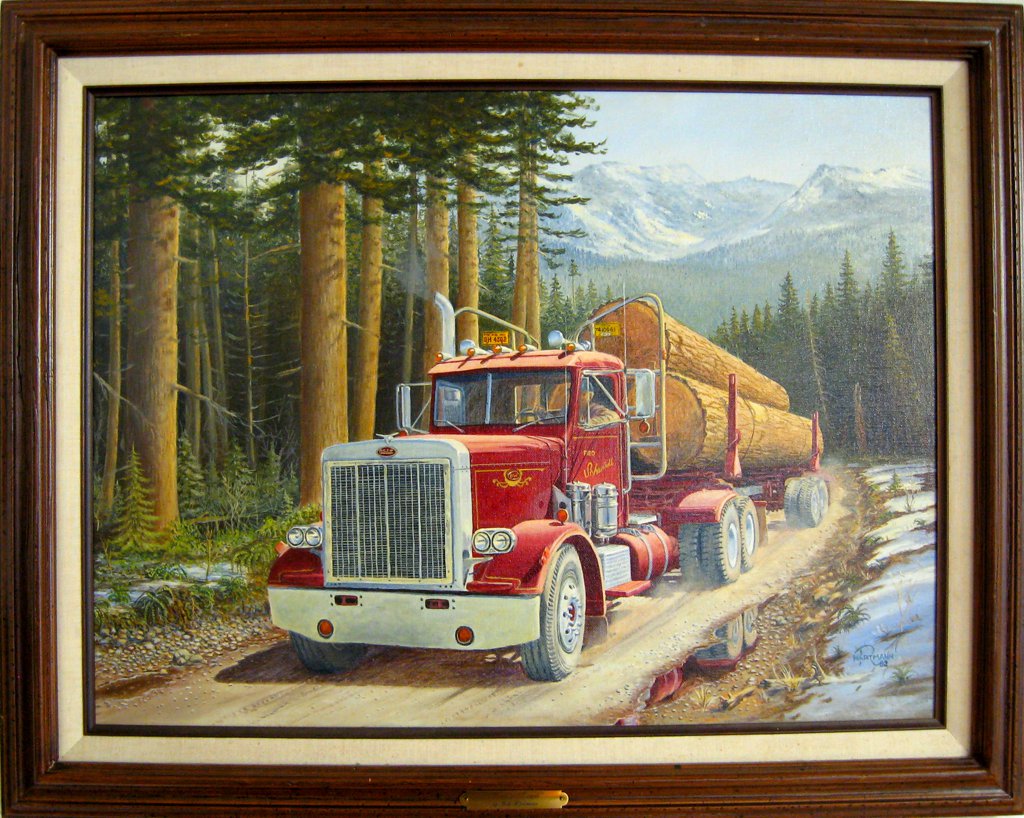



Photo 1
The original cross and ball (world)
Photo-2
Removing the original cross and ball
Photo-3
The metal bottom of the ball shows holes from the rifle
bullets sent heavenward by the pastor in the 1920s to discourage
roosting birds, but later providing access for bees. The center
wooden shaft of strong Douglas fir is the base of the cross.
Photo-4
The new cross and ball begins its ascent.
Photo-5
The new cross and ball is attached.
2011 - The September Sublimity Harvest Festival has grown hugely since 1972, mostly in a mechanical direction, but we still see the ever popular draft horses. Here are the Herman Hendrickses driving the Tim Bielenbergs' fine team and Oaklea Farm freight wagon. (It was my pleasure to tour downtown Sublimity in this conveyance on a recent summer evening.) Photo by Theresa Swearingen



2013, July, Fr. Paul Materu, ALCP is the new Administrator at St Boniface.

2016, July, Steve Tabor appointed as Deacon at St Boniface.

2017, April, Photo update of Saint Boniface Parish, modern day with rare double rainbow. Photo Credit: Steve Hanlon (2017-04-14)

2018, October, Saint Boniface celebrates its 100th Annual Parish Dinner. Sue M VanHandel tends to dozens of chickens to be served alongside homemade chicken and noodles, baked potato, green beans, coleslaw, rolls, pies/cakes.Photo Credit: Kim Zuber (2018-10-14)

A lot is changing in this unique and vital community. But more important are the good things that remain the same - the principles, purpose, and moral fiber that have so closely bound family and church and town. Presenting this history has fascinated and inspired me as I continue to learn about the community that we chose twenty-eight years ago.
All rights reserved © Henry Strobel 2003-2017. Your additions and corrections are welcome!